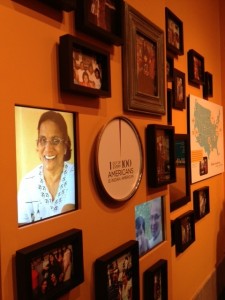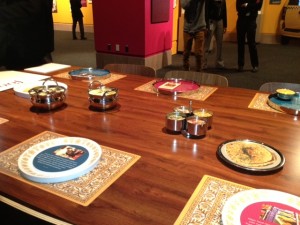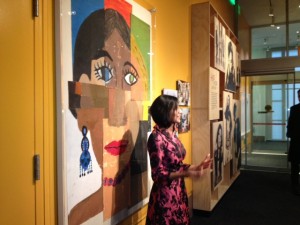Today marks the opening of Beyond Bollywood: Indian Americans Shape the Nation, a landmark exhibition on view until next year at the Smithsonian Natural History Museum. Whether you consider that Indian Americans number more than 3 million or that 1 out of 100 Americans is Indian American, we are a significant presence. And this 5,000-square-foot exhibition, the first major national exhibition to focus on Indians in America, seeks to highlight our cultural, professional, and political contributions.
 Beyond Bollywood is meaningful not just for its breakthrough content and scope but also for its rich and unexpected details. The exhibition carves the Indian American story into seven parts: Migration; Early Immigration; Working Lives; Arts and Activism; Yoga, Religion, & Spirituality; Cultural Contributions in Food, Music, Dance; and Groundbreakers.
Beyond Bollywood is meaningful not just for its breakthrough content and scope but also for its rich and unexpected details. The exhibition carves the Indian American story into seven parts: Migration; Early Immigration; Working Lives; Arts and Activism; Yoga, Religion, & Spirituality; Cultural Contributions in Food, Music, Dance; and Groundbreakers.
In “Migration and Early Immigration” the colorful walls are awash in family portraits and video installations recounting the journeys that Indians and their families made to the US, from as early as the 1700s to present time. “Working Lives” takes a nontraditional look inside traditional professions and livelihoods of Indian Americans, including physicians and motel owners. This recurring theme of exploring and transcending stereotypes of Indian Americans is echoed in every part of the exhibition and in its very name.
The curators revealed that when they surveyed people, Bollywood was the first thing people associated with Indians in America and so they paired it with Beyond, at once acknowledging this strong association, while also pushing the public to take a deeper look.
 Particularly noteworthy artifacts include the dress worn by First Lady Michelle Obama to the 2012 National Governors Association Dinner created by Indian American designer Naeem Khan and the trophy of the first Indian American National Spelling Bee winner, Balu Natarajan (1985). While these artifacts of achievement are stunning, the small details of the exhibition are no less impressive. For example, a typical Indian American dining table is laid out partially with steel thalis and partially with Corelle plate ware, both staples of Indian American households. And thalis do double duty on the walls, framing key statistics on Indian Americans.
Particularly noteworthy artifacts include the dress worn by First Lady Michelle Obama to the 2012 National Governors Association Dinner created by Indian American designer Naeem Khan and the trophy of the first Indian American National Spelling Bee winner, Balu Natarajan (1985). While these artifacts of achievement are stunning, the small details of the exhibition are no less impressive. For example, a typical Indian American dining table is laid out partially with steel thalis and partially with Corelle plate ware, both staples of Indian American households. And thalis do double duty on the walls, framing key statistics on Indian Americans.
However, the exhibit does not just celebrate the achievements and contributions of Indian Americans, it also highlights the challenges and tragedies we’ve faced in America, including identity issues and discrimination, and the ways in which we have responded. One of the most moving artifacts is Balbir Singh Sodhi’s turban. Sodhi was the first South Asian American to be killed in an act of retaliation following Sept 11, 2001. Meanwhile, in the “Arts and Activism” section, it’s reinvigorating to see how pioneering Indian American artists use their mediums to explore and challenge issues of identity.

It’s heartening to think that thousands of Indian Americans who journeyed to this country will make yet another journey to Washington, DC, in the next year and hopefully see themselves and their stories reflected for the first time along the walls of the Smithsonian. Some of them will be accompanied by their U.S.-born children, who may come away with a better understanding of their parents’ or grandparents’ migration and with one more piece of the puzzle that is their identity.
For those who can’t make the journey, Beyond Bollywood will be touring the US for five years starting in 2015 because the story of Indian Americans is one that stretches far and wide across the plains and cities of America.
You can learn more by reading The Aerograms’ interview with Beyond Bollywood’s curator, Masum Momaya and by visiting the Beyond Bollywood web site.
Photos courtesy of Kavita Das. After 15 years developing and leading innovative programs in the social change sector, Kavita Das now serves as a nonprofit consultant and writes nonfiction and creative nonfiction. Connect with Kavita on Twitter @kavitamix.
















1 thought on “Smithsonian’s ‘Beyond Bollywood’ Opens, Putting the Spotlight on Indians in America”
Comments are closed.